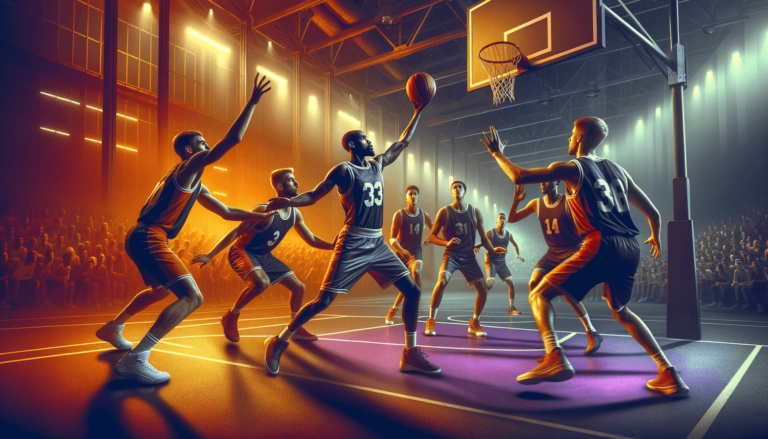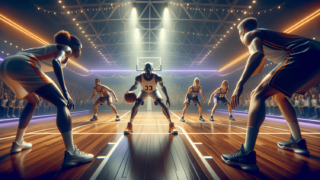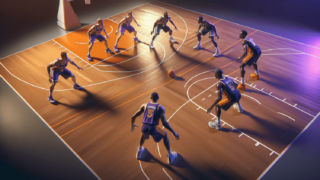
How to Improve Your Ball Security in Basketball?
Written by: Basketball Universe
Last updated:

It’s a well-known truth that possession is critical in the game of basketball, and impeccable ball security can often make the difference in a closely contested match. This fact makes our quest to explore various ways to enhance your ball protection skills not just timely, but vital for players seeking to raise their game to new heights. So grab your high-tops, and join us on this exciting voyage to learn everything there is to know about ball security as we deep-dive into the best practices, tips, and techniques that will empower you to become a formidable force on the court. Let’s bounce!
How to Improve Your Ball Security in Basketball?
Improving ball security in basketball is a multi-faceted endeavor that involves several key aspects. Start by strengthening your dribbling skills, focusing on controlling the ball and keeping it low with your fingertips. Practice dribbling with both your strong and weak hands while maintaining your head up to improve your court vision. Incorporate various tempo changes and crossovers to keep defenders guessing. Work on enhancing your overall body strength and balance to help you withstand defensive pressures. Finally, smart decision-making and anticipation of opponents’ moves will allow you to protect the ball and reduce turnovers effectively.
Master the Fundamentals of Dribbling
Ball security begins with a strong foundation in dribbling. There’s no time like the present to fine-tune your dribbling skills, enhancing your control over the ball and increasing your ability to dictate the game tempo. Let’s explore some techniques that will help you take charge of the ball with confidence.
Use Fingertip Control
When dribbling, it’s crucial to use your fingertips, not your palm, to maintain optimal control of the basketball. Practicing this technique will enable you to accurately direct the ball, execute cleaner crossovers, and deceive defenders. Furthermore, using your fingertips reduces the risk of accidental mishandling or losing control of the ball during high-pressure situations in a game.
Keep the Ball Low
One of the key principles to improvise your ball security is to limit the vertical distance between the basketball and the floor. By keeping the ball low during your dribble, you’ll minimize the chances of defenders swiping it away. Incorporate drills into your practice sessions that emphasize low dribbling, such as performing figure-eight dribbles around your legs or speed-dribbling close to the court surface.
Develop Your Weak Hand
Most basketball players have a dominant hand, but refining your ability to dribble with both hands will keep defenders off-balance and guessing. Schedule training sessions dedicated to enhancing your weak hand’s dribbling proficiency. This will ensure your ball security is robust when driving to the hoop or when facing up against aggressive defenders on either side.
Head Up, Eyes Forward
To expand your court vision, you must train yourself to dribble while keeping your head up and eyes forward. This enables you to monitor the movements of both teammates and opponents, improving your passing accuracy and decision-making. Try dribbling without looking at the ball by using peripheral vision or visualize a defender pressuring you as you maneuver around cones or other obstacles on the court.
Effective Change of Pace and Direction
One of the most powerful ball security tools at your disposal is your ability to change speed and direction abruptly. Remember, unpredictability is your friend, keeping your defender guessing and your basketball safe. Here are a few ways to leverage these game-changing skills:
Speed Transitions
Changing speeds in basketball can keep defenders at bay and increase your overall control. Start by incorporating exercises that transition from a jog to a sprint while dribbling the ball, allowing you to practice maintaining control at varying velocities. From stutter steps to sudden accelerations, integrating different speed dynamics will have a substantial impact on your ball security.
Master Crossovers and Misdirection
Crossover dribbles are moves that change the ball from one hand to the other rapidly, forcing your defender to shift their focus and disrupt their balance. By learning a variety of crossover techniques, such as the basic crossover, between-the-legs crossover, and behind-the-back crossover, you’ll become more adept at maintaining ball security and eluding oncoming defenders. Paired with misdirection techniques like pump fakes and pass fakes, you’ll keep opponents guessing and protect the ball more effectively.
Build Strength and Balance
Another key aspect of improving your ball security is to enhance your overall body strength and balance. These traits not only help you fend off aggressive defenders but also empower you to maintain complete control over the basketball.
Core Stability
A strong core is crucial for basketball players as it provides a stable base for dribbling and shooting. Include core exercises such as planks, Russian twists, and leg raises in your workout routine. By developing core stability, you’ll gain improved ball control and experience more success when protecting the ball during contact.
Upper Body Strength
Focusing on your upper body muscles creates the added advantage of being able to shield the basketball from defenders, hard fouls, and intense contact situations in the paint. Exercises like push-ups, dips, and resistance band workouts targeting your shoulders, arms, and chest will directly contribute to your ball security prowess on the court.
Lower Body Power and Balance
Lower body strength influences your ability to change direction, explode past defenders, and establish balance during contact situations. Dedicate time to perform exercises like squats, lunges, and box jumps. These activities will increase your leg power, enabling you to maintain the basketball’s control, especially when navigating traffic in the lane.
Cultivate Smart Decision-Making
At the heart of ball security is the ability to make intelligent decisions on the basketball court. This involves anticipating opponents’ moves, understanding when to pass or retain possession, and harnessing your mental agility to make split-second assessments.
Study Your Opponents
One of the most valuable habits to develop is studying your opponents and understanding their tendencies. By recognizing their strengths and weaknesses, you can improvise adaptive strategies that protect the ball and capitalize on opportunities. Whether through game film analysis, scouting reports, or watching live games, analyze your rivals to optimize your ball security tactics.
Know When to Pass
While you can’t always avoid turnovers, recognizing when and how to pass is vital in minimizing them. Maintain your court awareness by reading defenders’ movements and anticipating passing lanes. Develop the instinct to know when to make a quick pass versus holding onto or dribbling the basketball. Remember, your decision-making capacity will greatly influence your ability to protect the ball.
With diligent practice, targeted training, and thoughtful decision-making, mastering the techniques covered in this in-depth guide will undoubtedly bolster your ball security skills. Embrace each aspect of these guidelines as you embark on a transformational journey to becoming a more formidable player, and watch your opponents struggle to steal that precious basketball from your supreme control.
Develop a Better Triple-Threat Position
A strong triple-threat position promises enhanced ball security while also enabling you to efficiently execute passes, shoot, and dribble. By refining your triple-threat stance, you can maintain control of the basketball and quickly react to defenders’ pressure.
Refine Your Stance
Establish an effective triple-threat position by placing your dominant foot slightly forward, shoulder-width apart. Slightly bend your knees and lower your center of gravity to enhance balance and stability. This posture will prepare you for rapid movements and smoother transitions.
Secure The Ball
When you receive the basketball, hold it securely on your hip, opposite your dominant foot. Ensure your elbows are out, discouraging defenders from swiping the ball. This ball placement will not only improve your control but will also increase the ball’s security during one-on-one situations.
Practice Handling Pressure
In high-pressure game situations, maintaining strong ball security is more challenging. Practice handling defensive pressure to enhance your confidence and response in such scenarios.
Execute Pressure Drills
Include defensive pressure drills in your practice regimen to familiarize yourself with intense on-court circumstances. For example, engage in full-court one-on-one drills, wherein you attempt to progress the ball up the court under the pressure of a defender. These training sessions will teach you how to adapt and maintain ball security even when faced with aggressive defense.
Visualize Game Scenarios
Visualization techniques can be useful in preparing mentally for game-like pressure situations. Imagine different scenarios where you’ll need to protect the ball and how you’ll react. Regular visualization exercises will enhance your confidence in your ball security skills when confronted with real-game situations.
Employ Advanced Drills to Sharpen Skills
Adding advanced drills to your training routine will further develop your ball security abilities. The following two drills are designed to challenge your ball-handling proficiency.
Two-Ball Dribbling Drills
Two-ball dribbling drills require you to dribble simultaneously with both hands. This technique challenges your hand-eye coordination, weak hand control, and dribbling consistency. It also encourages you to maintain your head up and develop court vision. Experiment with various dribbling patterns for added complexity, such as alternating dribbles or dribbling at different speeds.
Resistance and Dribble Drills
Resistance dribble drills involve utilizing resistance bands or a weight vest while dribbling, compelling you to exert more force while maintaining control of the basketball. Rehearse various dribble moves, such as crossovers, hesitations, and between-the-legs drills, while wearing the resistance equipment. This practice will massively improve your ball security, even in strenuous situations.
By incorporating these additional strategies and drills into your training routine, you’ll witness significant improvements in your ball security. As you gain more confidence and exhibit stronger basketball control, you’ll develop into a dynamic and unstoppable force on the court.
FAQ Section: Enhancing Ball Security in Basketball
Find answers to the most frequently asked questions concerning ball security in basketball. Expand your knowledge and understanding of the essential aspects of this fundamental skill and discover how to take your game to new heights.
1. Why is ball security important in basketball?
Ball security is important because it allows you to maintain possession, minimize turnovers, and control the pace of the game. Good ball security also leads to better shot opportunities, assists, and overall team success.
2. How often should I practice dribbling to improve my ball security?
It is recommended to practice dribbling for at least 30 minutes every day to see significant improvements in ball security. Consistent practice enables you to develop muscle memory and enhances your overall control and confidence on the court.
3. Can I practice ball security alone, or do I need a partner?
While practicing alone can help you develop your dribbling and confidence with the ball, partnering with another player or practicing under defensive pressure will enhance your ball security skills, adaptability, and decision-making in real-game situations.
4. How should I hold the ball when not in motion to improve ball security?
When stationary, hold the ball securely with both hands on the sides or with one hand underneath and the other on the side. Keep the ball close to your body, and maintain control with your fingertips, ready to pass or dribble as needed. Your elbows should be slightly out to protect the ball from defenders trying to swipe it away.
5. What handles or moves can I use to protect the ball from defenders?
To protect the ball from defenders, utilize techniques like crossovers, hesitations, and change-of-direction moves. These moves include behind-the-back dribbles, between-the-legs dribbles, and spin moves. A good arsenal of ball-handling techniques will make it difficult for defenders to strip the ball from you.
6. How can I develop balance and strength to improve ball security?
Balance and strength can be developed by incorporating specific exercises such as core stability workouts, lower body strength training, and upper body muscle exercises. Activities like squats, lunges, push-ups, and planks will aid in building strength and balance, enabling you to maintain control of the basketball during gameplay.
7. How do body positioning and footwork affect ball security?
Effective body positioning and footwork can help shield the ball from defenders, prepare you for dribble moves, and retain control in contact situations. Adopting a low center of gravity through a strong triple-threat stance and maintaining an active pivot foot will significantly enhance your ball security.
8. Can my choice of basketball shoes impact ball security?
While basketball shoes themselves do not directly impact ball security, they can influence your stability, footwork, and responsiveness on the court. High-quality basketball shoes with proper support and grip can help you execute plays more effectively and safely, thus indirectly impact your ability to retain control of the ball.
9. How can I practice anticipating opponents’ moves for better ball security?
By analyzing game footage, scouting reports, or observing gameplay in person, you can study opponents’ tendencies and enhance your ability to react and adapt accordingly. Familiarizing yourself with rivals’ strengths and weaknesses will help optimize your ball security strategies during competitive matches.
10. How long does it take to see improvements in ball security?
The time it takes to see improvements in ball security varies depending on factors such as your current skill level, dedication to practice, and quality of coaching. Consistently investing in targeted practice sessions and embracing helpful feedback will expedite your progress towards better ball security.
Featured Posts
- No pillar pages found.





